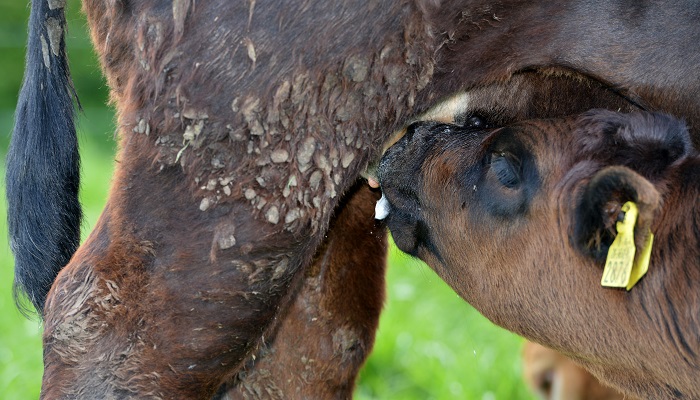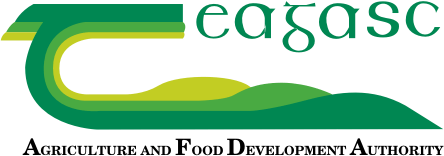09 April 2023
Breeding the next generation of cows with Future Beef Farmer John Dunne

Breeding choices made on suckler farms over the coming weeks have both short and long-term implications.
Although the short-term consequences can be seen as soon as animals arrive on the ground in terms of their calving ease, vigour, conformation and growth rates or at a slightly later date, when animals are sold, the longer-term impact of the correct or incorrect genetics will be present in your suckler herd for years to come due to the retention of replacement heifers to form the future generations of your suckler herd.
John Dunne, a participant in the Teagasc Future Beef Programme, who farms in Portarlington, Co. Offaly, not only plans to improve the reproductive performance of his suckler herd, but he has also put a plan in place to breed the future generation of his suckler cow herd with a specific focus on the Replacement Index.
Carrying 70 spring-calving suckler cows, with all progeny brought to beef, John wants to increase suckler cow numbers going forward. However, the existing herd needs to hit specific key performance indicators before increasing numbers.
Having clear fertility targets for a herd is one of the first goals in any farm plan. Output on a suckler farm is directly related to the number of live calves weaned each year. Calving heifers at 24 months of age, having a tight calving pattern, aiming for a short calving interval and keeping mortality to a minimum are some of the key targets.
The KPIs for John’s farm include: compact calving (80% of cows calved in 60 days); a 365-day calving interval; 0.95 calves reared/cow/year; a low culling rate (less than 5%); replacement heifers with a high Replacement Index; five/six calves/cow on average over her lifetime; less than 5% mortality by 28 days; and maximum use of crossbreeding (hybrid vigour) to improve cow fertility and calf survival.
Genetic improvement
Genetic improvements can be achieved through breeding heifers with a high Replacement Index, purchasing stock bulls that are five stars for the important beef traits and by using AI where possible to avail of bulls that have high reliability attached to their breeding values. Gains made from improving the genetics are cumulative and once achieved are there for the lifetime of the herd. Like John, every suckler farmer needs to have a breeding plan to ensure that the next generation of stock is superior to the previous generation.
The first step of the plan is to ascertain where the herd stands now in terms of performance and Replacement Index value. The ICBF 2022 reports highlights both positive and negative results.
Table 1: Top six key performance indicators (ICBF report)
| John’s herd | National average | Bottom 10% | Top 10% | |
|---|---|---|---|---|
| Calving interval (days) | 368 | 393 | 437 | 358 |
| Mortality – dead at birth (%) | 0 | 0.86 | 3.7 | 0 |
| Mortality – dead at 28 days (%) | 4.7 | 2.07 | 6.9 | 0 |
| Calves per cow per year | 0.61 | 0.87 | 0.68 | 1.02 |
| Percentage of heifers calved at 22-26 months | 0 | 24 | 0 | 75 |
| Spring six-week calving rate | 84 | 55 | 14 | 100 |
While the calving interval and six-week calving rate are on the right track in John’s herd, there is a big issue with calves/cow/year and mortality at 28 days. Reviewing 2022, there was an issue with the bull being sub-fertile and scanning revealed 12 empty cows. For 2023, John has fertility tested and carried out a bull NCT to ensure that he will be in good working order this year. As part of a new herd health plan, all calves are now vaccinated to reduce the incidences of pneumonia.
Looking at the Replacement Index of the existing cows, the ICBF report highlights that they are well above the average of €87. They are relatively balanced and have very good figures for daughter milk and calving interval. The only concern, given the system is beef finishing, is that the carcass weight trait is low and close to the national average of 10kg. This will need to increase and will be addressed when choosing replacement heifers and sires as part of the breeding plan.
Table 2: Average Beef Euro-Star values for cows on John’s farm
| Group | Index value | Across breed |
Carcass weight (across breed) |
Daughter milk (across breed) |
Daughter calving interval (across breed) |
|---|---|---|---|---|---|
| Cows with Euro-Stars | €111 | Five-star | +11kg | +8.9kg | -1.52 |
| First calvers | €137 | Five-star | +9kg | +13.2kg | -0.62 |
| Second calvers | €112 | Five-star | +17kg | +6.2kg | -1.72 |
| Third calvers + | €107 | Five-star | +9kg | +9.3kg | -1.56 |
| National average cows | €87 | +10kg | +5.52kg | -1.27 |
2023 breeding plan
There are currently two bulls on the farm. A Charolais bull is used as a terminal sire, not a replacement sire. An easy-calving Angus was purchased in 2022 and will be used on the maiden heifers. Both bulls are genotyped and will be eligible for the SCEP scheme. The breeding season will start on April 15th.
As there were no suitable home-bred heifers for breeding last year, 34 heifers were purchased in advance of the breeding season from one source. These were synchronised and fixed time AI was used. This was the first time AI was used on the farm. 21 proved in calf to AI bulls EBY, ZEP and LM2014. The Angus bull mopped up the remainder. With cow numbers back up to 70, the target is to breed more replacements on farm going forward.
John will now also use AI on the best 30 cows that calved early this year. To aid heat detection, a Friesian bull weanling has been purchased, vaccinated and vasectomised in March. He will be fitted with a chin-ball harness. To get more replacements, AI bulls with high Replacement Index values will be used, such as the Simmental bull Curaheen Gunshot P (SI4147). This bull is suitable for mature cows only and will also add to carcass weight.
As this is John’s first year using AI on cows, the plan is to AI for three weeks only and then introduce the Charolais bull. The fields around the yard have been closed so the cows will be grazing near the yard. John debated the use of sexed semen but felt that he needs to get more experience with using conventional AI first. Using AI gives a faster road to improving the overall genetics of the herd.
The target will be to calve all heifers at between 22 and 26 months of age. These heifers will be given priority treatment to ensure target weights are met at the different stages of their growth cycle.
For 2023, John will synchronise the maiden heifers again. It will work out at €60/head, but John feels that this is money well spent. As labour is an issue on such a large farm, it allows him to use fixed time AI on the heifers in a timed and controlled manner without the need for much observation. The heifers only need to be around the yard for 10 days and can then be moved to the out-farm with the Angus bull. The target is 70% conception rate this year. Ewdenvale Ivor (LM2014) is one of the bulls which will be used on the heifers.
John Dunne is a participant in the Teagasc Future Beef Programme. For more information on the programme, other farm updates and technical advice, click here.
Also read: Future Beef Update: Matching the bull with the cow and using sexed semen
